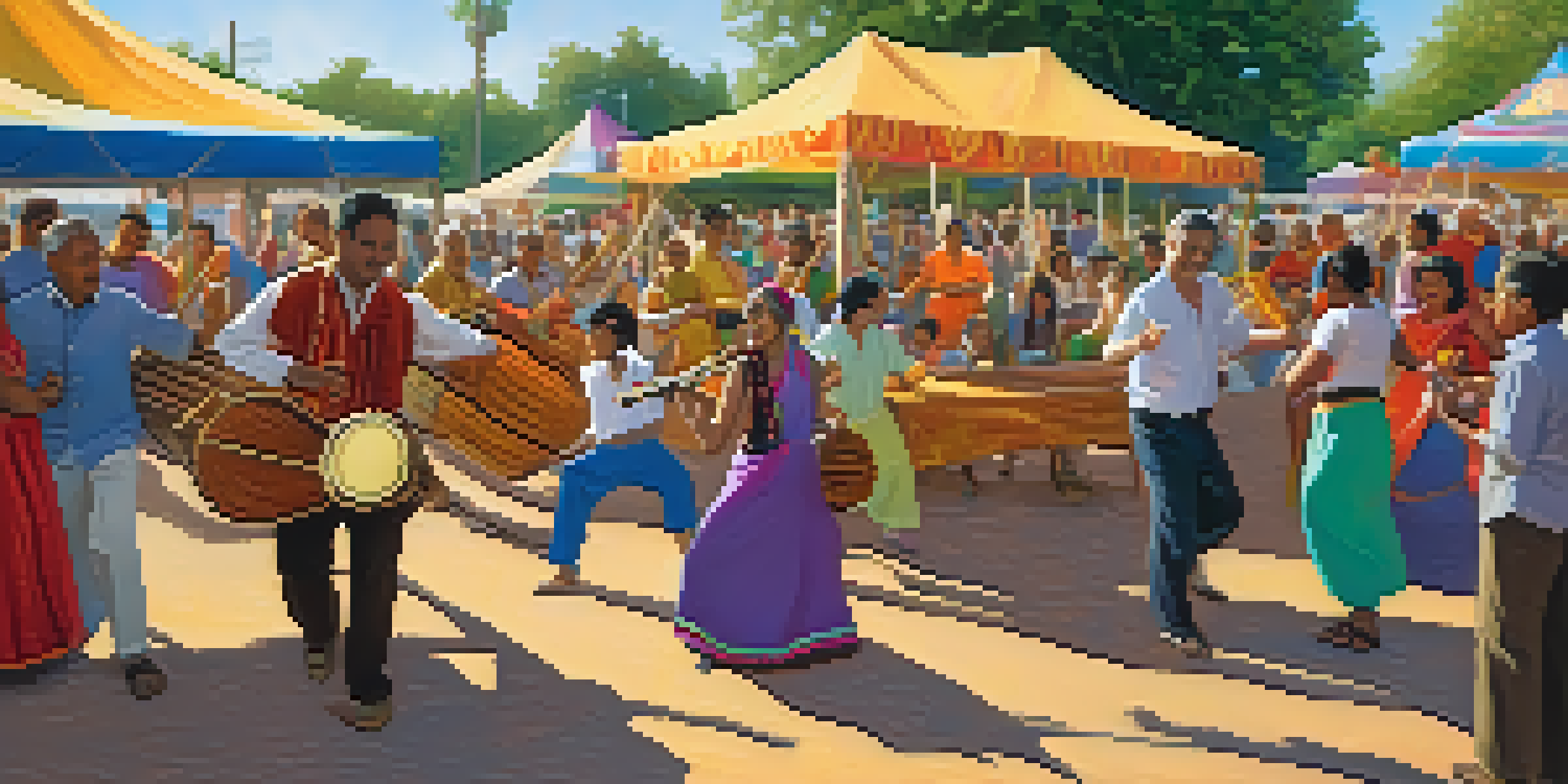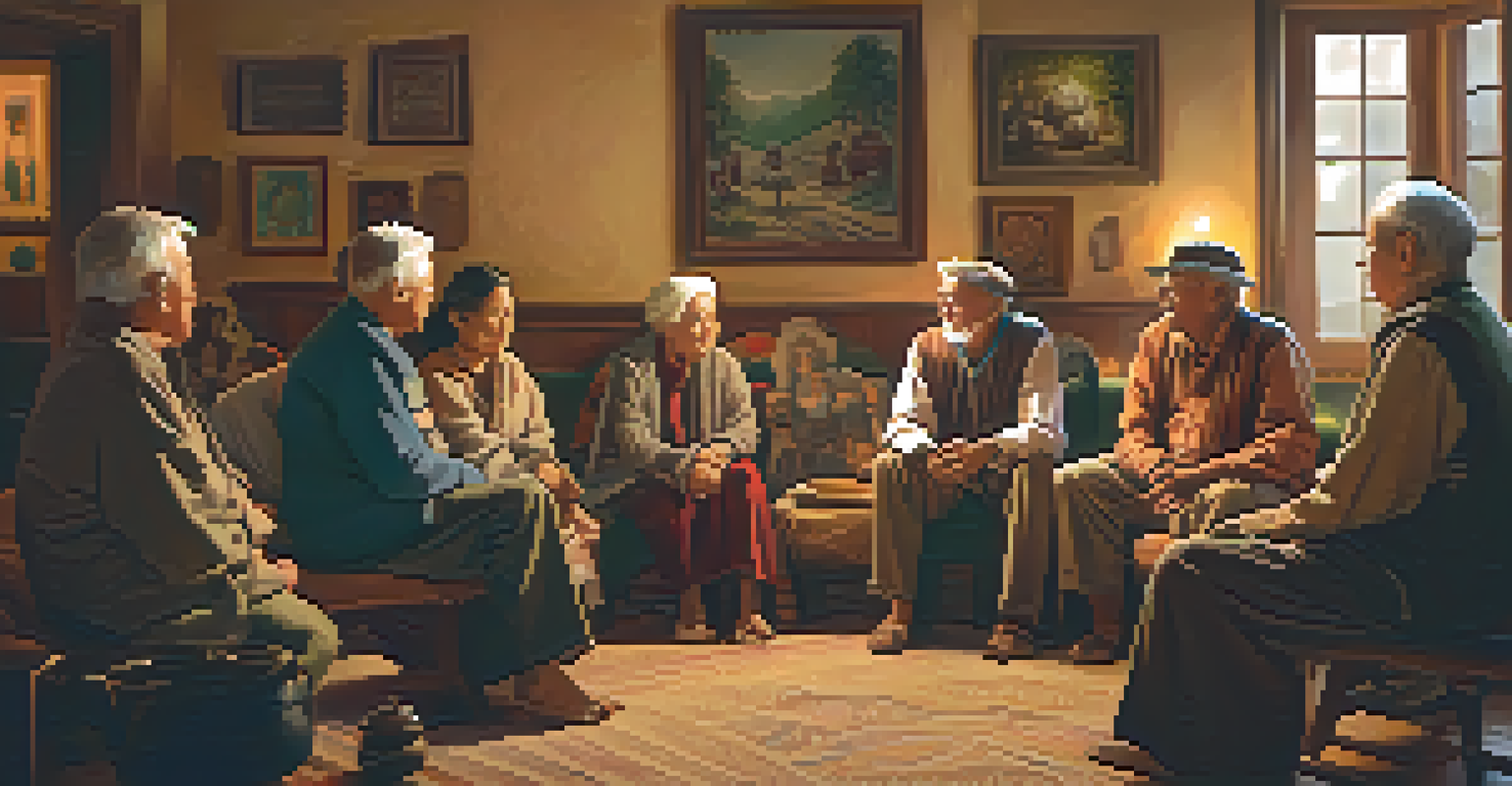The Therapeutic Benefits of Traditional Music in Communities

Traditional Music: A Universal Language for Healing
Traditional music serves as a universal language, capable of expressing emotions that words alone often cannot. From joyous celebrations to solemn rituals, these melodies resonate deeply within communities, creating a shared experience. This connection can be especially therapeutic, as it allows individuals to feel understood and supported, even in their most challenging times.
Music can change the world because it can change people.
For instance, consider a community gathering where local musicians play folk songs during a festival. The collective participation fosters a sense of belonging and emotional release, reminding everyone that they are part of something larger than themselves. This shared experience can ease feelings of isolation and promote emotional well-being.
Moreover, the rhythms and melodies of traditional music have been known to activate the brain's pleasure centers, releasing endorphins that enhance mood. Thus, engaging with traditional music not only uplifts spirits but also serves as a powerful therapeutic tool for community cohesion.
Cultural Identity and Music's Role in Strengthening Bonds
Music is a vital component of cultural identity, allowing communities to express their unique heritage. Traditional music acts as a vessel for cultural stories, values, and beliefs, often passed down through generations. When individuals participate in these musical traditions, they reinforce their connection to their roots and strengthen their sense of belonging.

For example, a community may hold regular events where elders teach younger generations traditional songs and dances. This not only preserves cultural heritage but also fosters intergenerational bonds, creating a sense of unity among all age groups. Such interactions can be incredibly beneficial for mental health, as they provide emotional support and a sense of purpose.
Music as a Healing Language
Traditional music serves as a universal language that fosters emotional connections and community support during challenging times.
Additionally, cultural music can serve as a powerful reminder of resilience, especially in communities that have faced adversity. By celebrating their heritage through music, these communities can find healing and hope, reinforcing their identity and solidarity.
Healing Through Shared Musical Experiences
Participating in musical activities as a group has profound therapeutic benefits. Whether it’s singing in a choir, playing instruments, or dancing, these shared experiences create a sense of community and connectedness. The act of making music together can significantly enhance social bonds and reduce feelings of loneliness.
Where words fail, music speaks.
Consider a local drum circle where participants of all ages come together to create rhythms. The act of drumming can be both exhilarating and cathartic, allowing individuals to express their emotions physically. This communal engagement fosters a supportive environment where everyone feels valued and included.
Moreover, shared musical experiences can serve as a form of emotional release, helping individuals process grief, joy, or stress. By coming together in this way, communities can collectively navigate their emotions, leading to healing and personal growth for all involved.
Traditional Music: A Tool for Mental Health Awareness
Traditional music can play a pivotal role in raising awareness about mental health issues within communities. By incorporating discussions about mental health into musical events, communities can break down stigmas and encourage open conversations. This can lead to greater understanding and support for those struggling with mental health challenges.
For instance, a community festival may feature local musicians who share songs inspired by their own mental health journeys. This not only entertains but also educates attendees about the importance of mental well-being. Such initiatives can empower individuals to seek help and foster a more supportive environment.
Cultural Identity Through Music
Engaging with traditional music strengthens cultural identity and intergenerational bonds, promoting unity and mental well-being.
Additionally, music therapy sessions that use traditional music can specifically target mental health issues. These sessions help participants explore their feelings and experiences creatively, offering a safe space for healing and self-expression.
Promoting Physical Health Through Traditional Music and Dance
Engaging with traditional music often involves physical movement, be it through dance or playing instruments, which can have positive effects on physical health. Dancing to traditional music can improve cardiovascular health, enhance coordination, and boost overall fitness levels. This makes traditional music not just a mental escape but also a physical workout.
Take the example of a community dance group that practices traditional folk dances regularly. Participants not only enjoy the social aspect of dancing together but also experience the benefits of regular physical activity. This combination of music and movement can lead to improved mood and increased energy levels.
Moreover, incorporating traditional music into health initiatives can encourage broader participation. Community health programs that include traditional music and dance can attract individuals who might otherwise shy away from exercise, making health more accessible and enjoyable.
Strengthening Community Resilience Through Music
In times of crisis or hardship, traditional music can serve as a source of strength and resilience for communities. It acts as a unifying force, bringing people together to support one another during difficult times. This collective strength is often expressed through music, as individuals find comfort and hope in shared experiences.
For example, after a natural disaster, communities may hold benefit concerts featuring traditional music to raise funds and support one another. These events not only provide financial assistance but also create a healing space for individuals to process their experiences together. The resilience demonstrated through music can inspire hope and recovery.
Music's Role in Mental Health
Incorporating traditional music into community events raises awareness about mental health and provides a therapeutic outlet for expression.
Moreover, traditional music can help communities articulate their stories and struggles, fostering a sense of agency and empowerment. By voicing their experiences through song, communities can reclaim their narratives and build a more resilient future.
The Role of Storytelling in Traditional Music Therapy
Storytelling is a fundamental aspect of traditional music, often conveying life lessons and cultural values. Through songs, communities can share their histories, struggles, and triumphs, which can be incredibly therapeutic. This narrative element allows individuals to connect with their past and find meaning in their experiences.
Consider a community elder sharing stories through songs at a gathering. These narratives can resonate deeply with listeners, evoking emotions and prompting reflection on their own lives. By engaging with these stories, individuals can gain insights and healing, as they recognize shared experiences and emotions.

Furthermore, integrating storytelling into music therapy can enhance its effectiveness. Participants can express their own stories through music, facilitating personal healing and growth while also building connections with others who share similar journeys.
Conclusion: Embracing the Healing Power of Traditional Music
In conclusion, the therapeutic benefits of traditional music in communities are both profound and wide-reaching. From fostering emotional connections to promoting physical health, traditional music serves as a powerful tool for healing and unity. By embracing these musical traditions, communities can create supportive environments that enhance well-being and resilience.
As we look to the future, it is essential to recognize and preserve these musical heritages. Supporting local musicians and participating in traditional music events can help ensure that these valuable cultural practices continue to thrive. They not only enrich individual lives but also strengthen community bonds.
Ultimately, the healing power of traditional music is a testament to its enduring importance in fostering connection, understanding, and well-being in our communities. Let's celebrate and engage with these musical traditions, allowing them to guide us on our journey toward healing.